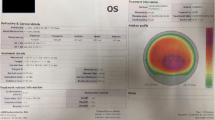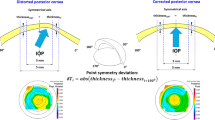Abstract
PresbyLASIK uses the principles of LASIK surgery to create a multifocal pseudoaccommodative corneal surface. It increases corneal asphericity to increase the depth of field, allowing for improved near focus. There are two predominant presbyLASIK techniques: peripheral presbyLASIK and central presbyLASIK. Peripheral presbyLASIK creates a myopic ablation in the mid-peripheral cornea to allow for near vision. Central presbyLASIK creates a central ablation that focuses for near vision. A third technique, termed micro-monovision presbyLASIK, combines presbyLASIK with monovision, where the dominant eye is corrected as an emmetrope for distance, while the non-dominant eye is corrected slightly myopic in either a central presbyLASIK or peripheral presbyLASIK ablation pattern. We present a brief review of results from papers and posters on presbyLASIK published in the recent 5–6 years. Two newer techniques for ablation patterns currently being investigated, isovision and prebyond, are also briefly discussed.




Similar content being viewed by others
References
Papers of particular interest, published recently, have been highlighted as: • Of importance •• Of major importance
Alio JL, Azar DT, Stasi K, Soria FA. Surgical correction of presbyopia. In: Yanoff M, Duker JS, editors. Ophthalmology: expert consult, vol. 4. Philadelphia: Elsevier; 2014. p. 151–3.
• Alarcon A, Anera RG, Jimenez del Barco L, Jimenez JR. Designing multifocal corneal models to correct presbyopia by laser ablation. J Biomed Opt. 2012;17(1):1–9. Good basic article summarizing the ablation profiles to make a cornea multifocal.
Telandro A. Pseudo-accommodative cornea: a new concept for correction of presbyopia. J Refract Surg. 2004;20(5):S714–7.
Telandro A. The pseudoaccommodative cornea multifocal ablation with a center-distance pattern: a review. J Refract Surg. 2009;25(1):S156–9.
•• Gordon M. Presbyopia corrections with the WaveLight Allegretto: 3-month results. J Refract Surg. 2010;26(10):S824–6. Key paper on PresbyLASIK using double ablations to achieve correction. Patients had good results.
Pinelli R, Ortiz D, Simonetto A, Bacchi C, Sala E, Alio JL. Correction of presbyopia in hyperopia with center-distance, paracentral-near technique using the Technolas 217z platform. J Refract Surg. 2008;24(5):494–500.
Gamaly TO, El Danasoury AM, Hantera M. Multizone LASIK with peripheral near zone for correction of presbyopia in myopic and hyperopic eyes: 1-year results. J Refract Surg. 2009;25(3):296–305.
•• Alio JL, Ortiz D, Sala E. Correction of presbyopia by central biaspheric multifocal LASIK in myopic patients. ASCRS Annual Meeting. 2009. Although yet to be published this presentation showed multifocal LASIK could be achieved with varying optical zones.
Uthoff D, Holland D, Poelzl M, Hepper D, Gulati A. Pseudoaccommodative cornea: option for correcting presbyopia using excimer laser platform. ASCRS Annual Meeting. 2010.
Vejarano LF, Sevilla LM. Different ways to treat presbyopia with excimer laser. ASCRS Annual Meeting. 2010.
Alio JL, Luger MH, Uthoff D, Wahab TA, Martines E. Multicentric experience with excimer laser platform for restoring near vision. ASCRS Annual Meeting. 2011.
Holland D, Uthoff D, Poelzl M, Hepper D. PresbyLASIK monovision for simultaneous correction of presbyopia and ametropia in 32 patients with LASIK. ASCRS Annual Meeting. 2013.
Rigal-Sastourne JC. Surgical correction of presbyopia in hyperopic patients using PresbyLASIK. ASCRS Annual Meeting. 2013.
Luger MHA, Ewering T, Arba-Mosquera S. One-year experience in presbyopia correction with biaspheric multifocal central presbyopia laser in situ keratomileusis. Cornea. 2013;32(5):644–52.
Riccomini EG, Pena PM, Bonilla DR. Binocular treatment varifocal: 1-year experience in Chile. ASCRS Annual Meeting. 2014.
Abdala A, Castrillon V, Lopez de Mesa C, Gutierrez AM. PresbyLASIK treatment for correcting presbyopia in hyperopic eyes. Invest Opohthalmol Vis Sci. 2014;55:E-Abstract 1541, ARVO Annual Meeting. 2014.
Hehn F. Presby-LASIK Isovision: far and near in both eyes without monovision. Tokyo: World Ophthalmology Congress; 2014.
Reinstein DZ, Couch DG, Archer TJ. LASIK for hyperopic astigmatism and presbyopia using micro-monovision with the Carl Zeiss Meditec MEL 80. J Refract Surg. 2009;25(1):37–58.
Reinstein DZ, Archer TJ, Gobbe M. LASIK for myopic astigmatism and presbyopia using non-linear aspheric micro-monovision with the Carl Zeiss Meditec MEL 80 Platform. J Refract Surg. 2011;27(1):23–37.
Reinstein DZ, Carp GI, Archer TJ, Gobbe M. LASIK for the correction of presbyopia in emmetropic patients using aspheric ablation profiles and a micro-monovision protocol with the Carl Zeiss Meditec MEL 80 and VisuMax. J Refract Surg. 2012;28(8):531–9.
Reinstein DZ, Archer TJ, Gobbe M. Stereoacuity after corneal presbyopic LASIK in myopic, hyperopic and emmetropic patients. ESCRS Annual Meeting, Vienna. 2011.
Disclosure
Dr. Lingo and Dr. Walter declare that there are currently no conflicts of interests.
Human and Animal Rights and Informed Consent
This article contains no studies with human or animal subjects performed by any of the authors.
Author information
Authors and Affiliations
Corresponding author
Additional information
This article is part of the Topical collection on Refractive Surgery: From Laser to Intraocular Lenses.
Rights and permissions
About this article
Cite this article
Lai, L.Y., Walter, K.A. PresbyLASIK Techniques and Outcomes. Curr Ophthalmol Rep 3, 9–15 (2015). https://doi.org/10.1007/s40135-015-0062-z
Published:
Issue Date:
DOI: https://doi.org/10.1007/s40135-015-0062-z




